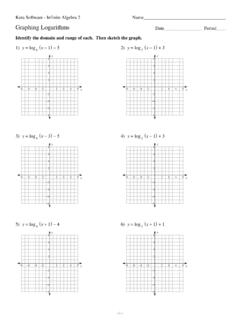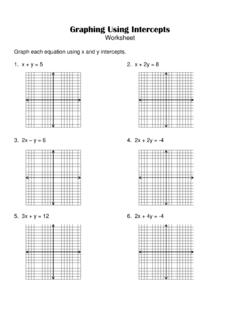Transcription of Graphing Standard Function & Transformations
1 Created by UASP Student Success Centers | 480-965-9072 Graphing Standard Function & Transformations A few Standard graphs f(x) = x f(x) = x2 f(x) = 1 x f(x) = x1/2 f(x) = x3 f(x) = x Created by UASP Student Success Centers | 480-965-9072 Graphing Standard Function & Transformations The rules below take these Standard plots and shift them horizontally/ vertically Vertical Shifts Let f be the Function and c a positive real number. The graph of y = f(x) + c is the graph of y = f(x) shifted c units vertically upwards. The graph of y = f(x) - c is the graph of y = f(x) shifted c units vertically downwards. g(x) = x2 + 2 = f(x) + 2 h(x) = x2 3 = f(x) 3 Look for the positive and negative sign. Positive sign makes the graph move upwards and the negative sign makes it move downwards Here is a picture of the graph of g(x) = x2 1.
2 It is obtained from the graph of f(x) = x2 by shifting it down 1 unit. Created by UASP Student Success Centers | 480-965-9072 Graphing Standard Function & Transformations Horizontal Shifts Let f be a Function and c a positive real number. The graph of y = f (x + c) is the graph of y = f (x) shifted to the left c units. The graph of y = f (x + c) is the graph of y = f (x) shifted to the right c units. g(x) = (x-3)2 = f (x-3) h (x) = (x + 2)2 = f (x+2) Here is a picture of the graph of g(x) = |x4|. It is obtained from the graph of f(x) = |x| by shifting it to the right 4 units. Horizontal/ Vertical Scaling Horizontal Scaling Let g(x) = f(cx) where c is a positive real number. Created by UASP Student Success Centers | 480-965-9072 Graphing Standard Function & Transformations If c > 1, the graph of g is the graph of f, compressed in the x-direction by a factor of c.
3 If 0 < c < 1, then the graph is stretched in the x-direction by a factor of 1/c Here is a picture of the graph of g(x) = ( )3. Since c = < 1, the graph is obtained from that of f(x) = x3 by stretching it in the x-direction by a factor of 1/c = 2. Vertical Scaling Let g(x) = cf(x) here c is a positive real number. If c > 1, the graph of g is the graph of f, stretched in the y-direction by a factor of c. Created by UASP Student Success Centers | 480-965-9072 Graphing Standard Function & Transformations If 0 < c < 1, then the graph is compressed in the y-direction by a factor of 1/c. Here is a picture of the graph of g(x) = 3(x)1/2. Since c = 3 > 1, the graph is obtained from that of f(x) = x1/2 by stretching it in the y-direction by a factor of c = 3. Reflection about the x axis The graph of y = - f (x) is the graph of y = f (x) reflected about the x- axis.
4 Here is a picture of the graph of g(x) = (x 2 1). It is obtained from the graph of f(x) = x 2 1 by reflecting it in the x-axis. Created by UASP Student Success Centers | 480-965-9072 Graphing Standard Function & Transformations Reflection about the y axis The graph of y = f (-x) is the graph of y = f (x) reflected about the y-axis. Here is a picture of the graph of g(x) =( )3+1. It is obtained from the graph of f(x) = +1 by reflecting it in the y-axis. Summary of Transformations To graph Draw the graph of f and: Changes in the equation of y = f(x) Vertical Shifts y = f (x) + c y = f (x) c Raise the graph of f by c units Lower the graph of f by c units C is added to f (x) C is subtracted from f (x) Created by UASP Student Success Centers | 480-965-9072 Graphing Standard Function & Transformations Sample Question: Sketch the curve for g(x) = Solve for yourself.
5 Horizontal Shifts y = f (x + c) y = f (x c) Shift the graph of f to the left c units Shift the graph of f to the right c units x is replaced with x + c x is replaced with x c Reflection about the x axis y = - f(x) Reflects the graph of f about the x axis f (x) is multiplied by 1 Reflection about the y axis y = f(-x) Reflect the graph of f about the y axis X is replaced with x Created by UASP Student Success Centers | 480-965-9072 Graphing Standard Function & Transformations











